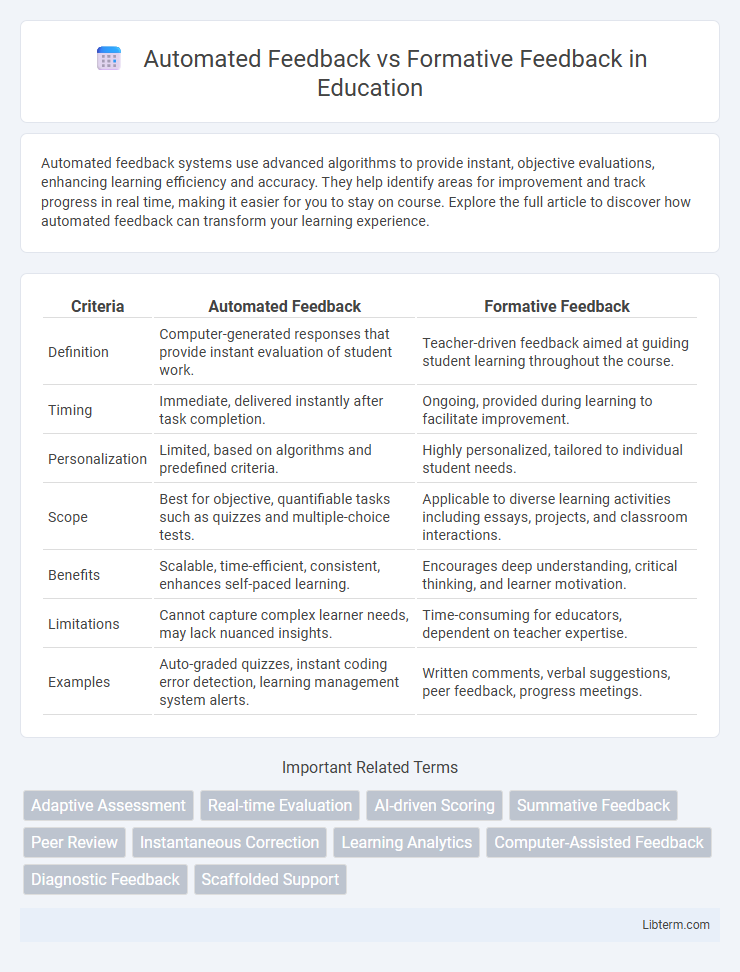Automated feedback systems use advanced algorithms to provide instant, objective evaluations, enhancing learning efficiency and accuracy. They help identify areas for improvement and track progress in real time, making it easier for you to stay on course. Explore the full article to discover how automated feedback can transform your learning experience.
Table of Comparison
| Criteria | Automated Feedback | Formative Feedback |
|---|---|---|
| Definition | Computer-generated responses that provide instant evaluation of student work. | Teacher-driven feedback aimed at guiding student learning throughout the course. |
| Timing | Immediate, delivered instantly after task completion. | Ongoing, provided during learning to facilitate improvement. |
| Personalization | Limited, based on algorithms and predefined criteria. | Highly personalized, tailored to individual student needs. |
| Scope | Best for objective, quantifiable tasks such as quizzes and multiple-choice tests. | Applicable to diverse learning activities including essays, projects, and classroom interactions. |
| Benefits | Scalable, time-efficient, consistent, enhances self-paced learning. | Encourages deep understanding, critical thinking, and learner motivation. |
| Limitations | Cannot capture complex learner needs, may lack nuanced insights. | Time-consuming for educators, dependent on teacher expertise. |
| Examples | Auto-graded quizzes, instant coding error detection, learning management system alerts. | Written comments, verbal suggestions, peer feedback, progress meetings. |
Understanding Automated Feedback in Education
Automated feedback in education leverages artificial intelligence and machine learning algorithms to provide immediate, personalized responses to student input, enhancing engagement and learning efficiency. Unlike traditional formative feedback, which depends on instructor evaluation and may be delayed, automated systems analyze patterns and errors in real time, allowing learners to adjust strategies promptly. This technology integrates natural language processing and data analytics to support diverse learning styles and continuously monitor progress at scale.
Defining Formative Feedback: Key Characteristics
Formative feedback is characterized by its ongoing, interactive nature, providing learners with timely, specific insights aimed at improving their understanding and skills during the learning process. Unlike automated feedback, which is typically immediate and generated by algorithms, formative feedback often involves personalized, context-sensitive responses from educators that foster reflection and adjustment. This type of feedback is essential for identifying learning gaps and guiding instructional strategies to enhance student performance effectively.
Core Differences Between Automated and Formative Feedback
Automated feedback relies on algorithms and software to instantly analyze student responses, providing quick, consistent, and objective assessments, whereas formative feedback involves personalized, ongoing input from educators aimed at guiding student learning and improvement. The core difference lies in automation and immediacy versus human judgment and adaptability, with formative feedback emphasizing context, motivation, and deeper understanding. Automated feedback excels in scalability and efficiency, while formative feedback offers tailored support critical for complex skill development and conceptual growth.
The Role of Technology in Delivering Automated Feedback
Technology plays a pivotal role in delivering automated feedback by utilizing algorithms and artificial intelligence to provide immediate, personalized, and consistent responses to learners. Automated feedback systems analyze student inputs in real-time, enabling quicker identification of errors and misconceptions compared to traditional formative feedback methods. This approach enhances learning efficiency by supporting continuous assessment and adaptive instruction without requiring direct teacher intervention.
Human Touch: The Importance of Personalized Formative Feedback
Automated feedback systems offer rapid responses but often lack the nuanced understanding that personalized formative feedback provides. Human educators tailor feedback to individual learning needs, addressing subtle misconceptions and fostering deeper engagement. This personalized approach enhances motivation and supports effective skill development beyond what automated tools can achieve.
Advantages of Automated Feedback Systems
Automated feedback systems provide instantaneous responses that accelerate the learning process by allowing learners to promptly correct mistakes and reinforce concepts. These systems offer scalable and consistent evaluation across large groups, reducing instructor workload while maintaining accuracy in assessment. Integration of data analytics in automated feedback enhances personalized learning pathways by identifying specific strengths and weaknesses in students' understanding.
Limitations and Challenges of Automated Feedback
Automated feedback systems often face limitations in accurately interpreting nuanced student responses, leading to potential misunderstandings or incomplete guidance compared to human-provided formative feedback. Challenges include the inability to assess complex reasoning, contextual subtleties, and emotional aspects of learning, which can hinder personalized support. Additionally, reliance on algorithms may result in generic or overly simplistic feedback that fails to address individual learner needs effectively.
Effectiveness of Formative Feedback in Student Learning
Formative feedback significantly enhances student learning by providing personalized, timely insights that help identify strengths and areas for improvement. Unlike automated feedback, which often relies on algorithmic responses, formative feedback involves qualitative, contextualized guidance from educators that fosters critical thinking and deeper understanding. Research shows students receiving formative feedback demonstrate improved performance, motivation, and engagement, making it a more effective tool for educational development.
Integrating Automated and Formative Feedback: Best Practices
Integrating automated feedback with formative feedback enhances personalized learning by combining real-time data-driven insights and nuanced instructor guidance. Effective practices include aligning automated feedback parameters with learning objectives, using analytics to identify student misconceptions, and ensuring timely human intervention to address complex issues. Leveraging adaptive algorithms alongside targeted teacher input fosters continuous improvement and deeper understanding.
Future Trends in Feedback Methods for Education
Automated feedback systems leverage AI algorithms and real-time data to provide personalized, instantaneous responses, enhancing student engagement and learning efficiency. Formative feedback, traditionally teacher-driven, will increasingly integrate with automated tools to offer more adaptive and scalable insights tailored to individual learning paths. Future trends indicate a hybrid approach combining AI-driven analytics with human judgment to optimize feedback accuracy and support deeper cognitive development in educational environments.
Automated Feedback Infographic

 libterm.com
libterm.com